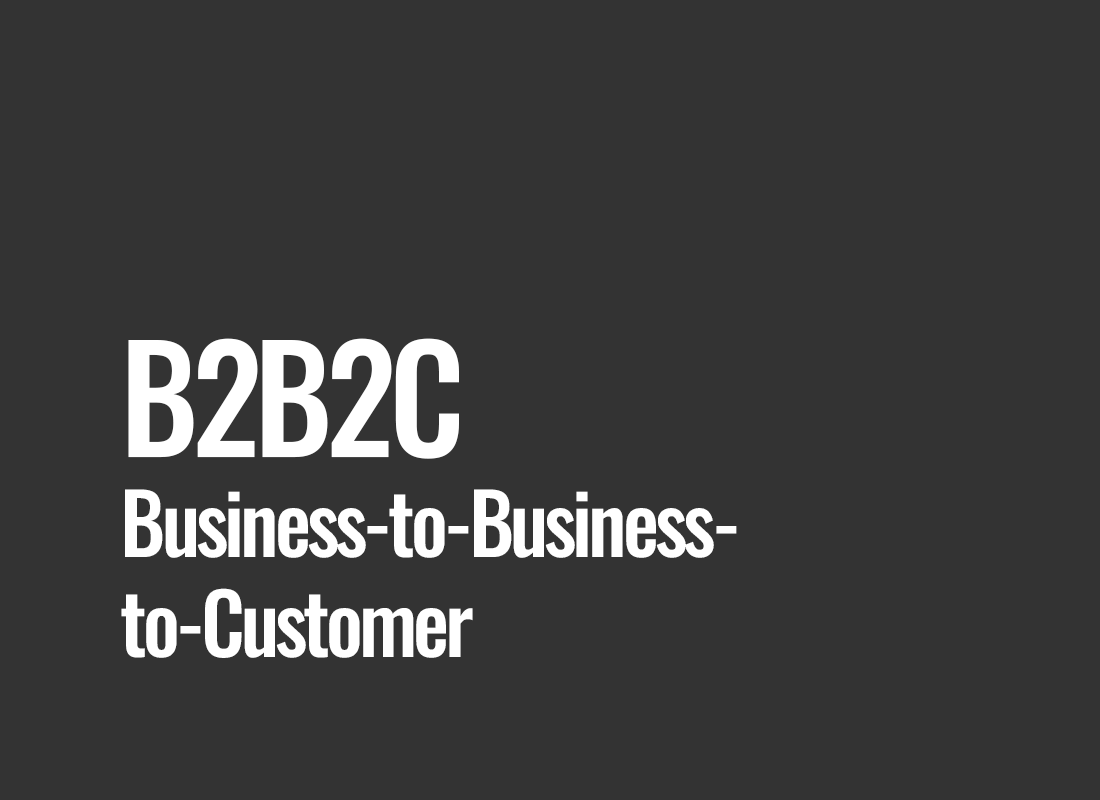B2B2C (Business-to-Business-to-Customer)
In the world of business and e-commerce, the concept of B2B2C (Business-to-Business-to-Customer) has become an integral part of the strategy of many companies, especially those aiming for dynamic growth in the era of digital transformation. This advanced approach to the business model leverages the synergistic combination of relationships between businesses (B2B) and the relationship between the company and the end consumer (B2C). B2B2C is not just an acronym or a concept; it's a way to revolutionize how companies reach their customers and generate revenue.
Defining B2B2C, it can be described as a strategy where a company not only delivers its products or services to other businesses (B2B) or directly to consumers (B2C) but also establishes an intermediary relationship between businesses and end customers. It is a bridge connecting the B2B and B2C realms, opening new opportunities and growth potential for companies. In this article, we will take a closer look at B2B2C, understanding its mechanisms, and analyzing the benefits it brings to companies.
B2B2C, while at first glance may seem complex, is based on a simple premise: a company acts as an intermediary, allowing other businesses and end consumers access to its products or services. However, the effects of this business model go much deeper. Before we delve into specific examples and effects, it's important to understand exactly how B2B2C works.
Consider a scenario where an electronics gadget manufacturer decides to implement a B2B2C strategy. In a traditional B2B model, this manufacturer would sell its products to wholesale suppliers, other businesses, or distributors. Whereas in the B2C model, the company would offer products directly to end customers via its e-commerce platform or brick-and-mortar stores.
In the B2B2C case, this manufacturer partners with a large retail chain that already has a broad customer base. The retail chain acts as an intermediary, offering the manufacturer's products to its customers. As a result, the retail seller's customers gain access to new products, and the electronics manufacturer expands its market presence, reaching a much larger group of customers than in the B2B or B2C model.
One of the key benefits of B2B2C is expanding a company's scope of operations and faster growth. Companies that utilize this strategy can reach customers that would be challenging to access independently. Moreover, the mediation of a retail company adds value to products by tailoring them to customer needs and offering additional services, such as customer support, delivery, or personalization.
It's also worth noting that B2B2C can help companies build customer loyalty and gain their trust. Customers often trust their favorite retailers and are more willing to try new products or services recommended by these companies. This trust can translate into long-term relationships and a steady flow of customers.
Amazon Business
One of the most notable examples of the B2B2C strategy implementation is the "Amazon Business" platform. The e-commerce giant, Amazon, began its operations as a B2C platform, offering products to end consumers. However, as the company grew and market needs changed, Amazon decided to expand its offering towards B2B. As a result, the "Amazon Business" platform was born, enabling companies to purchase products and services essential for their operations.
Amazon Business acts as an intermediary between suppliers and companies, thereby creating a B2B2C model. A company can enjoy the benefits of shopping on Amazon, such as a wide product selection and fast delivery, while also receiving business-tailored tools, like VAT invoices and special corporate payment cards. This mediation by Amazon connects suppliers with companies in need of their products.
The result is increased product accessibility for companies and a streamlined purchasing process. Companies that previously had to rely on traditional suppliers can now easily and efficiently source through Amazon Business. This model not only facilitates companies' access to the necessary resources but also allows Amazon to expand its influence on the B2B market, creating a dynamic ecosystem.
Alibaba
Another exemplary instance of B2B2C is the Chinese e-commerce platform, Alibaba. It's a vast platform that operates on a global scale, enabling Chinese and international manufacturers to sell their products to both other businesses and end consumers.
Alibaba offers various tools and services tailored to entrepreneurs' needs. One of the key components of the Alibaba ecosystem is AliPay, an online payment system facilitating transactions between businesses and customers.
Importantly, Alibaba allows manufacturers to set up their online stores where they can showcase their products, build their brand, and communicate with customers. This creates unique opportunities for businesses to utilize Alibaba's global visibility and reach to access customers worldwide.
Salesforce Commerce Cloud
Salesforce, primarily known as a provider of advanced CRM (Customer Relationship Management) tools, has also recognized the potential of the B2B2C model. The company created the Salesforce Commerce Cloud, an e-commerce platform that combines B2B and B2C elements, enabling businesses to build and manage online stores.
The Salesforce Commerce Cloud allows companies to create personalized shopping experiences, tailoring offers to the individual needs of customers. Through integration with CRM systems, companies can better manage customer relationships, analyze purchasing data, and make more informed business decisions.
It's a B2B2C model that is transforming the way companies build relationships with their customers. Companies not only provide products but also create interactive and personalized experiences, which in turn leads to customer loyalty and a greater chance for long-term success.
Gaining a Competitive Edge through B2B2C
It's worth noting that B2B2C offers companies not only the opportunity to expand the market but also to gain a competitive advantage. In today's world, where competition is fierce, innovation and value-added are key success factors.
For example, an electronic gadget manufacturer using B2B2C may collaborate with a retail company to deliver its products to consumers. However, the retailer not only sells these products but also offers additional services, such as device training or extended warranties. This way, the retailer adds value to the manufacturer's products and strengthens its relationship with customers.
This shows that B2B2C is not just about delivering products, but also about creating comprehensive solutions and shopping experiences that attract customers and build loyalty. Companies that approach collaboration and value delivery innovatively become leaders in their industries.
Challenges and Trends in B2B2C
While B2B2C brings many benefits, it also poses certain challenges. One is the need for effective management of relationships with business partners, especially in complex global supply chains. Moreover, competition in this business model can be fierce, so companies must constantly invest in innovation and adapt to changing market needs.
A major trend in B2B2C is the growing importance of personalization and personalized shopping experiences. Companies that can tailor their offerings to individual customer needs gain a competitive edge. Additionally, technologies like artificial intelligence and data analysis are evolving, allowing companies to better understand their customers and adjust offers.
Another significant trend is the growing importance of ecology and social responsibility. Customers increasingly value companies that care about the environment and the community. Companies that engage in sustainable development and act for the benefit of society can build a positive image and gain customer loyalty.
Conclusions from the above examples and trends are clear: B2B2C is a business model evolving with digital transformation and changing market needs. Companies that can harness intermediation and collaboration with other companies and consumers stand a chance for dynamic growth and building lasting relationships with customers. However, success in B2B2C requires not only strategy but also innovation, flexibility, and continuous adaptation to the changing business environment. It's a model that benefits both companies and customers, creating a win-win scenario in the era of digital transformation.
Summary
B2B2C, the business model connecting Business-to-Business-to-Customer, is not just an abbreviation or fleeting trend. It's a strategy that shapes the future of business and e-commerce. On our journey through the world of B2B2C, we've looked at application examples, understood the mechanisms of operation, and analyzed the benefits it brings to companies. Now it's time for a summary and reflection on the significance of this business model.
B2B2C is an effective way to transform traditional relationships between companies and customers. Companies not only deliver products or services but also build long-term relationships with business partners and end customers. Intermediation and value addition are the keys to success in B2B2C. Companies that can deliver more than just a product become more competitive and gain customer trust.
Examples like Amazon Business, Alibaba, or Salesforce Commerce Cloud show the diversity of B2B2C applications. From e-commerce platforms to CRM tools, this model impacts various industries and opens new business opportunities. It's also a way for global expansion, allowing companies to reach customers worldwide.
However, success in B2B2C is not guaranteed. Companies must be prepared for the challenges this model brings. Effective management of relationships with business partners, developing innovative solutions, and adapting to changing market needs are crucial. Competition in B2B2C can be fierce, so companies need to be creative and flexible.
One of the key trends in B2B2C is personalization. Customers expect personalized shopping experiences and individually tailored offers. Companies that understand their customers and deliver what they need have a competitive advantage. This is also a way to build customer loyalty and lasting relationships.
Another significant trend is social and environmental responsibility. Customers increasingly appreciate companies that engage in sustainable development and act for the benefit of society. Companies that care about the environment, employees, and the community build a positive image and gain customer loyalty.
In conclusion, B2B2C is a dynamic business model that becomes increasingly significant in the era of digital transformation. Companies that can leverage intermediation and collaboration with other companies and consumers can achieve significant market success. This model not only transforms the way companies deliver products and services but also builds lasting relationships with customers and creates a win-win scenario. It's worth being prepared for the challenges and opportunities B2B2C brings and act innovatively in the dynamic business world.




